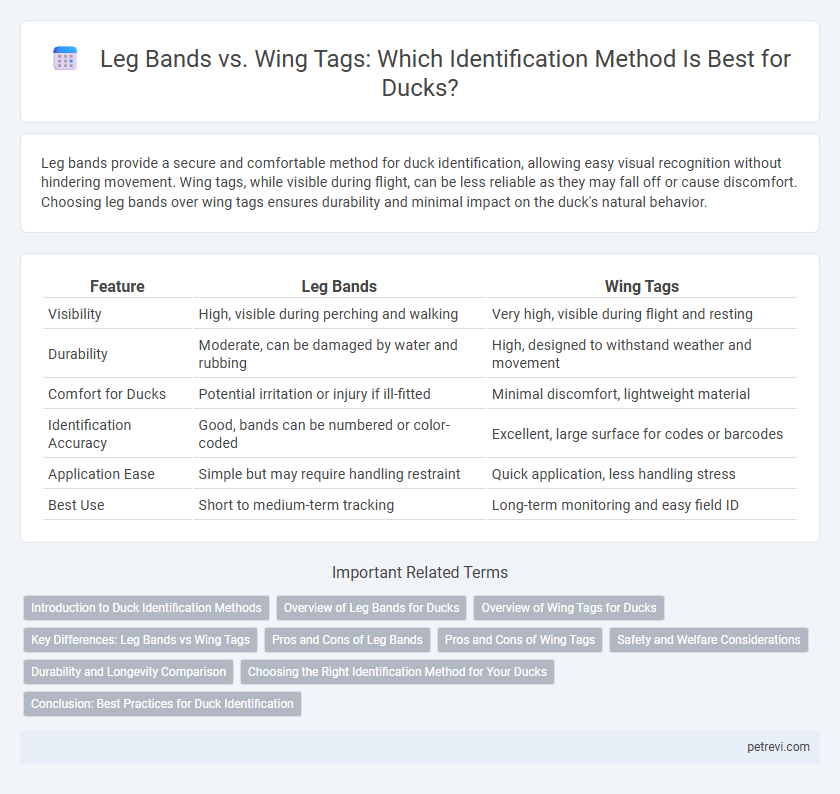Leg bands provide a secure and comfortable method for duck identification, allowing easy visual recognition without hindering movement. Wing tags, while visible during flight, can be less reliable as they may fall off or cause discomfort. Choosing leg bands over wing tags ensures durability and minimal impact on the duck's natural behavior.
Table of Comparison
| Feature | Leg Bands | Wing Tags |
|---|---|---|
| Visibility | High, visible during perching and walking | Very high, visible during flight and resting |
| Durability | Moderate, can be damaged by water and rubbing | High, designed to withstand weather and movement |
| Comfort for Ducks | Potential irritation or injury if ill-fitted | Minimal discomfort, lightweight material |
| Identification Accuracy | Good, bands can be numbered or color-coded | Excellent, large surface for codes or barcodes |
| Application Ease | Simple but may require handling restraint | Quick application, less handling stress |
| Best Use | Short to medium-term tracking | Long-term monitoring and easy field ID |
Introduction to Duck Identification Methods
Leg bands and wing tags are primary methods for identifying ducks in research and wildlife management, each offering distinct advantages. Leg bands provide durable, permanent markers that withstand water and environmental exposure, facilitating long-term tracking of individual birds. Wing tags offer increased visibility during flight and monitoring but may be less durable and more prone to loss compared to leg bands.
Overview of Leg Bands for Ducks
Leg bands for ducks provide a durable and reliable method for individual identification, typically made of lightweight metal or plastic that withstands water exposure and daily wear. These bands are available in various sizes and colors, allowing easy visual differentiation and tracking of ducks in scientific studies, breeding programs, or flock management. Their secure fit on the bird's leg ensures minimal interference with natural behavior while enabling long-term monitoring and data collection.
Overview of Wing Tags for Ducks
Wing tags for ducks offer a lightweight, visible method of identification that minimizes discomfort and interference with natural behaviors. Made from durable, waterproof materials, these tags attach to the wing without hindering flight, allowing for easy monitoring in both wild and captive populations. Their bright colors and unique codes enhance tracking accuracy while reducing stress during routine handling or research activities.
Key Differences: Leg Bands vs Wing Tags
Leg bands offer a durable and secure method for duck identification, often made of lightweight metal or plastic that can withstand harsh environmental conditions. Wing tags, typically made of colored plastic with printed numbers or codes, provide high visibility from a distance, making them suitable for quick visual identification during flight or in large flocks. Key differences include leg bands' resistance to loss due to secure fitting around the leg, while wing tags may be easier to apply but have a higher risk of detachment.
Pros and Cons of Leg Bands
Leg bands for duck identification provide a durable and permanent method for tracking individual birds, allowing researchers to monitor behaviors and migration patterns over time. However, leg bands can cause discomfort, skin irritation, or entanglement, potentially affecting the duck's natural movements. Despite these drawbacks, they remain a popular choice due to their visibility and ease of reading at a distance.
Pros and Cons of Wing Tags
Wing tags provide a visible and easily accessible method for duck identification, allowing researchers and owners to quickly distinguish individual birds without the need for handling. However, they can sometimes interfere with natural wing movement, potentially affecting flight and causing discomfort over extended periods. Compared to leg bands, wing tags are more prone to damage or detachment during active behaviors like swimming or preening.
Safety and Welfare Considerations
Leg bands offer a safer and less invasive method for duck identification, reducing the risk of wing damage and impaired flight associated with wing tags. Wing tags can cause entanglement or irritation, compromising the duck's welfare and mobility. Prioritizing leg bands helps maintain natural behaviors while ensuring accurate tracking and monitoring.
Durability and Longevity Comparison
Leg bands offer superior durability and longevity for duck identification, made from corrosion-resistant materials like aluminum or stainless steel that withstand harsh environmental conditions over extended periods. Wing tags, often constructed from lightweight plastic, are more susceptible to damage, fading, or loss due to exposure to water, sun, and physical wear. Studies indicate leg bands maintain legibility and structural integrity for multiple seasons, whereas wing tags typically require more frequent replacement to ensure reliable identification.
Choosing the Right Identification Method for Your Ducks
Leg bands provide a durable and reliable method for duck identification, offering clear visibility and minimal interference with natural behavior. Wing tags are lightweight and less intrusive, making them suitable for ducks in flight or more active environments. Selecting the right identification method depends on factors such as the duck's activity level, habitat, and the need for long-term tracking accuracy.
Conclusion: Best Practices for Duck Identification
Leg bands provide a secure and durable method for duck identification, ensuring minimal impact on the bird's natural behavior and long-term visibility. Wing tags offer more visual clarity from a distance but may increase the risk of snagging or loss due to wing movement. Combining leg bands with wing tags optimizes identification accuracy and durability, catering to both close-range monitoring and long-distance observation needs.
Leg Bands vs Wing Tags for Duck Identification Infographic

 petrevi.com
petrevi.com